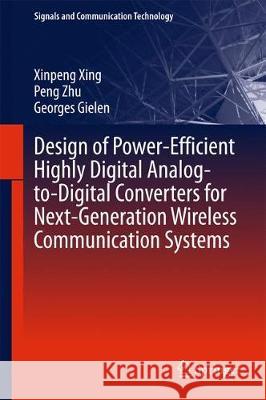Design of Power-Efficient Highly Digital Analog-To-Digital Converters for Next-Generation Wireless Communication Systems » książka



Design of Power-Efficient Highly Digital Analog-To-Digital Converters for Next-Generation Wireless Communication Systems
ISBN-13: 9783319665641 / Angielski / Twarda / 2017 / 181 str.
Design of Power-Efficient Highly Digital Analog-To-Digital Converters for Next-Generation Wireless Communication Systems
ISBN-13: 9783319665641 / Angielski / Twarda / 2017 / 181 str.
(netto: 384,26 VAT: 5%)
Najniższa cena z 30 dni: 385,52 zł
ok. 22 dni roboczych
Bez gwarancji dostawy przed świętami
Darmowa dostawa!
MATLAB simulation files
Introduction.- A–D Converters and Their Applications.- Continuous-Time Delta–Sigma ADCs.- VCO-Based ADCs.- 40MHz-BW 12-bit Low-Power CT Delta–Sigma ADCs in 90nm CMOS.- Two-step Open-Loop VCO-Based ADC.- VCO-based 0-2 Delta–Sigma MASH ADCs.- Fully-VCO-based High-order Delta–Sigma ADCs.- Conclusions.
Prof. Xinpeng Xing received his Bachelor and Master degrees both in Electronics Engineering from Beijing University of Aeronautics and Astronautics and Tsinghua University respectively. In October 2013, He is granted with PhD degree in engineering in KU Leuven, his doctor thesis is about design of high-bandwidth low-power Delta-Sigma Modulators. Now he is an assistant professor at Graduate School at Shenzhen, Tsinghua University, and his research interest is analog, mixed-mode, RF integrated circuits design.
Georges G.E. Gielen Has been a Full Professor at Katholieke Universiteit Leuven since 2000 and, since August 2012, has served as Chair of the Department of Electrical Engineering. He is also the Chair of the Leuven ICT research center, and the PI coordinator of the Leuven CHIPS Center of Excellence.
His research interests are in the design of analog and mixed-signal integrated circuits, and especially in analog and mixed-signal CAD
tools and design automation (modeling, simulation and symbolic analysis, analog synthesis, analog layout generation, analog and mixed-signal testing). He is coordinator or partner of several (industrial) research projects in this areas. He has authored or coauthored 7 books and more than 450 papers in edited books, international journals and conference proceedings. He is regularly a member of the Program Committees of international conferences, having served as General Chair of the DATE conference in 2006 and of the ICCAD conference in 2007. He serves regularly as member of editorial boards of international journals (IEEE Transactions on Circuits and Systems, IEEE Transactions on Computer-Aided Design, Springer International Journal on Analog Integrated Circuits and Signal Processing, Elsevier Integration).
He received the 1995 Best Paper Award in the John Wiley international journal on Circuit Theory and Applications, and was the 1997 Laureate of the Belgian Royal Academ
y on Sciences, Literature and Arts in the discipline of Engineering. He received the 2000 Alcatel Award from the Belgian National Fund of Scientific Research for his innovative research in telecommunications, and won the DATE 2004 conference Best Paper Award. He served as appointed member of the Board of Governors of the IEEE Council on Electronic Design Automation, and as Chairman of the IEEE Benelux CAS Chapter. He served as the President of the IEEE Circuits and Systems Society in 2005, and as Chair of the IEEE Benelux Section in 2009-2011. He is the Chair of EDAA. He was elected DATE Fellow in 2007, and received the IEEE Computer Society Outstanding Contribution Award and the IEEE Circuits and Systems Society Meritorious Service Award in 2007. He is a Fellow of the IEEE.This book discusses both architecture- and circuit-level design aspects of voltage-controlled-oscillator (VCO)-based analog-to-digital converters (ADCs), especially focusing on mitigation of VCO nonlinearity and the improvement of power efficiency. It shows readers how to develop power-efficient complementary-metal-oxide-semiconductor (CMOS) ADCs for applications such as LTE, 802.11n, and VDSL2+. The material covered can also be applied to other specifications and technologies.
Design of Power-Efficient Highly Digital Analog-to-Digital Converters for Next-Generation Wireless Communication Systems begins with a general introduction to the applications of an ADC in communications systems and the basic concepts of VCO-based ADCs. The text addresses a wide range of converter architectures including open- and closed-loop technologies. Special attention is paid to the replacement of power-hungry analog blocks with VCO-based circuits and to the mitigation of VCO nonline
arity. Various MATLAB®/Simulink® models are provided for important circuit nonidealities, allowing designers and researchers to determine the required specifications for the different building blocks that form the systematic integrated-circuit design procedure.Five different VCO-based ADC design examples are presented, introducing innovations at both architecture and circuit levels. Of these designs, the best power efficiency of a high-bandwidth oversampling ADC is achieved in a 40 nm CMOS demonstration.
This book is essential reading material for engineers and researchers working on low-power-analog and mixed-signal design and may be used by instructors teaching advanced courses on the subject. It provides a clear overview and comparison of VCO-based ADC architectures and gives the reader insight into the most important circuit imperfections.
1997-2025 DolnySlask.com Agencja Internetowa
KrainaKsiazek.PL - Księgarnia Internetowa









